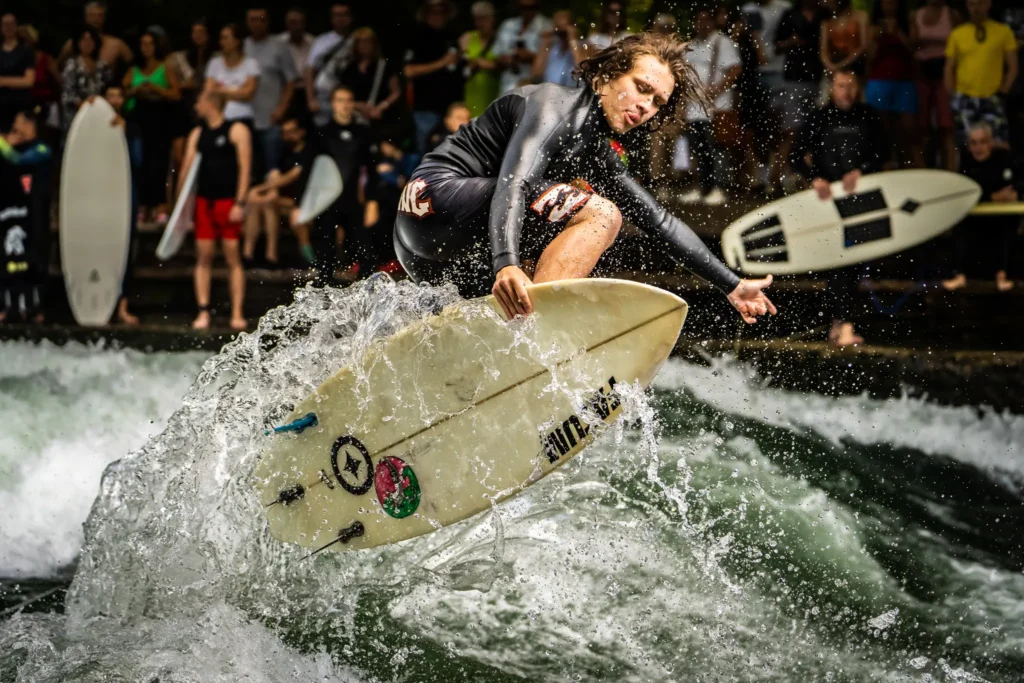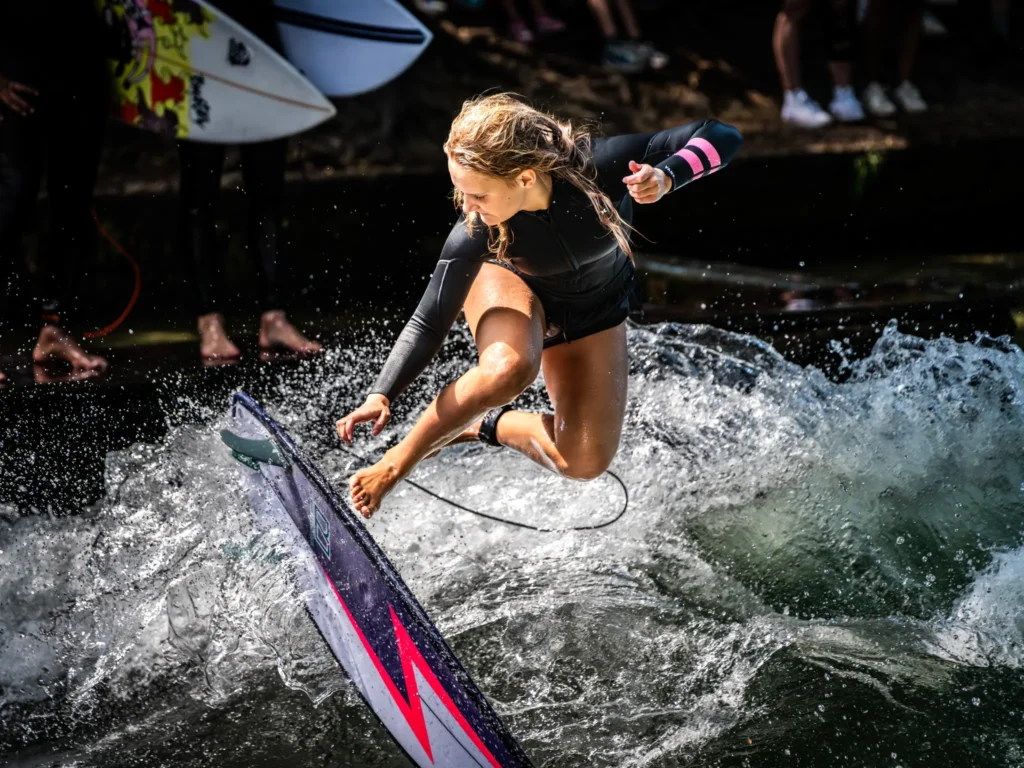A Wave in the Pithy of a City
When people think of surfing, they imagine golden coastlines, endless horizons, and sun-bleached beaches. Rarely does the mind turn to Munich, a city better known for its beer gardens, Baroque churches, and the annual flood of Oktoberfest. Yet tucked inside its English Garden, one of Europe’s largest urban parks, flows the Eisbach, a narrow tributary of the Isar River. For decades, a single standing wave here has offered surfers a paradoxical paradise: an ocean sport in the middle of a landlocked city.
But paradise has rarely been secure. In the 1990s and early 2000s, authorities threatened to close down the wave, citing safety hazards and liability concerns. What followed was a grassroots movement—half rebellion, half negotiation—that united surfers, artists, lawyers, and ordinary citizens to protect one of Munich’s most unlikely cultural treasures. Their campaign not only saved the Eisbach but elevated it into a global symbol of urban surfing.
The Birth of an Urban Surf Culture
The Eisbach wave was never designed for recreation. In the 1970s, adventurous locals discovered that a small stone step in the channel created a standing wave powerful enough to ride. Word spread among Munich’s youth, and over the next two decades, a small but dedicated subculture formed.
These surfers weren’t chasing sunshine or long breaks; they were carving against a wall of rushing water in a freezing stream. The culture developed its own codes—board modifications to withstand the river’s force, neoprene gear to combat the cold, and a rotation system where surfers line up on the bank before launching themselves in. The Eisbach became a proving ground: unforgiving, dangerous, and exhilarating. To master it was to earn instant credibility.
Rising Tensions with Authorities
Despite its popularity, the Eisbach wave existed in a legal gray area. The city had never sanctioned surfing there, and officials viewed it with suspicion. Complaints from residents about noise and safety only fueled the tension. By the late 1990s, signs were posted declaring surfing illegal, and police patrols attempted to enforce the ban.
Authorities argued that the river was too dangerous, liability risks too high, and accidents too likely. Surfers, however, insisted that the danger was precisely what made it authentic. For them, the Eisbach wasn’t a leisure activity but a way of life. The looming closure galvanized the community, forcing them to organize not just in the water but in the public square.
A Grassroots Movement Emerges
What set Munich’s surfers apart was their ability to build alliances beyond their own ranks. Artists, musicians, environmentalists, and local business owners rallied to the cause. The Eisbach wave wasn’t just about surfing—it was about the city’s identity as a place where tradition and innovation coexisted.
Activists staged demonstrations, petitioned city councils, and even lobbied Bavaria’s cultural ministry. International surf brands took notice, framing the Eisbach as a rare and authentic surf spot, unlike anything else in the world. The movement gained visibility through media campaigns, photo exhibitions, and documentaries.
A key turning point came when lawyers sympathetic to the cause developed proposals to mitigate the city’s liability concerns. By clarifying responsibilities and introducing limited safety measures, they made it possible for officials to reconsider without losing face.
More Than a Sport
What ultimately saved the Eisbach was not a technical solution but a cultural argument. Surfers and supporters reframed the wave as a heritage site, part of Munich’s living culture. Just as beer halls, orchestras, and football clubs defined the city, so too did this improbable surf scene.
International attention reinforced the point. Tourists began flocking to the Eisbach not just to surf but to watch. The wave became a theater of skill, courage, and community, attracting crowds who would gather on the bridge above to cheer. The Eisbach shifted from being a nuisance to being a civic spectacle—something Munich could celebrate rather than suppress.
Official Recognition and Legalization
By the mid-2000s, the momentum was unstoppable. In 2010, the Bavarian government officially recognized river surfing as a legal sport. The Eisbach wave was formally declared open for surfers, albeit with posted warnings: “Surfing at your own risk.” It was a pragmatic compromise—acknowledging the dangers while affirming the rights of surfers to decide for themselves.
For Munich, this was a landmark decision. It signaled a willingness to embrace subculture as culture, to support activities that defied convention. It also solidified the Eisbach’s reputation internationally, making Munich one of the unlikely capitals of global surf culture.
The Eisbach Today: Global Pilgrimage Site
Today, the Eisbach wave is more than just a local secret. Surfers from around the world travel to Munich to test themselves against its power. Professional athletes use it to train, while tourists crowd the banks to marvel at the spectacle.
The lineup remains orderly, governed by unwritten rules of fairness and respect. Surfers launch in one at a time, each ride lasting only seconds before giving way to the next. There is little of the territorial hostility found on ocean beaches; the Eisbach’s tight quarters demand cooperation.
Beyond surfing, the wave has become a symbol of urban resilience. It represents the idea that cities can nurture subcultures that defy geography, and that communities can shape policy when they speak with passion and persistence.
The Broader Bequest of Munich’s Surfers
The success of the Eisbach campaign has inspired similar efforts elsewhere. River waves in Switzerland, Austria, and even the United States have gained legitimacy by pointing to Munich’s example. It also sparked conversations about how urban spaces can be reimagined for unconventional recreation.
For Munich, the Eisbach remains a reminder of how culture is never static. What began as an act of youthful rebellion is now enshrined as part of the city’s identity. The surfers who once risked fines to ride the wave are now ambassadors for a sport that thrives in defiance of geography.
Impression: A Culture Secured
The story of how Munich’s inner-city surfers saved their beloved river wave is more than a tale of activism—it is a parable about belonging, resilience, and cultural recognition. Against bureaucracy and skepticism, a community of surfers insisted that their passion mattered, that their wave was worth preserving.
Today, as crowds gather to watch riders carve against the relentless current of the Eisbach, it is clear that they were right. The wave endures not only as a physical phenomenon but as a cultural one—a reminder that sometimes the heart of a city beats strongest in the most unexpected places.
No comments yet.










